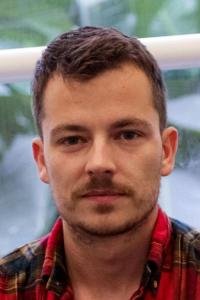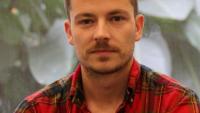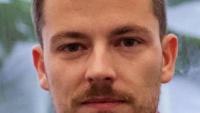Mijo Simunovic
- Assistant Professor of Chemical Engineering

Overview
Academic Appointments
- Assistant Professor of Chemical Engineering
Credentials & Experience
Honors & Awards
- Science/AAAS and SciLifeLab Prize for Young scientists in Cell and Molecular Biology, 2017
- Chancellor’s thesis prize from the Sorbonne Universities, 2016
- Thesis prize from the French Nanoscience Society Nano-K, 2016
- Yang Cao-Lan-Xian best thesis award in Physical Chemistry, University of Chicago, 2015
- Albert J. Cross prize for excellence in research, teaching, and departmental citizenship, University of Chicago, 2014
- Peter Kollman award in high performance computing, American Chemical Society, 2012
- Physical Sciences Division teaching prize, University of Chicago, 2012
- Bronze medal at the 37th International Chemistry Olympiad in Taipei, Taiwan, 2005
Research
Mijo Simunovic creates quantitative models of embryogenesis using human pluripotent stem cells, to study the molecular mechanisms and the biomechanics of embryo implantation, gastrulation, and organ formation.
The first days of animal embryo development are perhaps the most remarkable example of tissue self-organization in all of biology. This process comprises several key developmental milestones, including implantation, the separation of the embryo from the placenta, and gastrulation, which establishes the coordinate system on which all the future organs will form. Perhaps one of the oldest questions in all of biology is how, despite tremendous conservation in embryonic pathways, we develop into completely differently looking organisms – a human always looks like a human and a mouse always looks like a mouse. If we understand these phenomena in great detail, we can harness them and faithfully mimic organ formation in a lab. At the interface of chemical engineering, developmental biology and biophysics, Mijo Simunovic uses human pluripotent stem cells to elucidate the molecular details and the biomechanics underlying early human embryogenesis and organogenesis, with goals to advancing reproductive and regenerative medicine and to faithfully modeling complex human diseases.
Organoids are complex tissues derived from stem cells that mimic important aspects of actual organ formation, including biochemical signaling, cellular diversity, and tissue transformations. Simunovic has previously generated an organoid model of the human epiblast, which is the embryonic tissue that gives rise to all the organs. He used this model to demonstrate the molecular mechanism of symmetry breaking, the key first step in establishing the body plan. Following on these efforts, Simunovic builds quantitative organoids to mimic the mechanisms of human embryo implantation and gastrulation; essentially, to understand how we are formed. Beyond elucidating basic biology, Simunovic engineers organoid assays to model various diseases. He is particularly interested in understanding mechanisms of very early embryogenesis whose impairment is the leading cause of pregnancy failure and ectopic pregnancies. Working with biologists and clinicians, Simunovic is also building organ-on-chip technologies to understand the complexity of organ tissues and to modeling complex human diseases.
Simunovic received his BS and MS in Chemistry from the University of Zagreb. He received his first PhD in Theoretical Chemistry from the University of Chicago and his second PhD in Condensed Matter Physics from the Curie Institute and the University of Paris VII. He conducted his postdoctoral research in Stem Cell and Developmental Biology at the Rockefeller University as a Junior Fellow of the Simons Society of Fellows. In 2016 he received the Chancellor’s prize from the Sorbonne Universities and in 2017 he won the Science/AAAS & SciLifeLab Prize for Young Scientists in Cell and Molecular Biology.
Organoids are complex tissues derived from stem cells that mimic important aspects of actual organ formation, including biochemical signaling, cellular diversity, and tissue transformations. Simunovic has previously generated an organoid model of the human epiblast, which is the embryonic tissue that gives rise to all the organs. He used this model to demonstrate the molecular mechanism of symmetry breaking, the key first step in establishing the body plan. Following on these efforts, Simunovic builds quantitative organoids to mimic the mechanisms of human embryo implantation and gastrulation; essentially, to understand how we are formed. Beyond elucidating basic biology, Simunovic engineers organoid assays to model various diseases. He is particularly interested in understanding mechanisms of very early embryogenesis whose impairment is the leading cause of pregnancy failure and ectopic pregnancies. Working with biologists and clinicians, Simunovic is also building organ-on-chip technologies to understand the complexity of organ tissues and to modeling complex human diseases.
Simunovic received his BS and MS in Chemistry from the University of Zagreb. He received his first PhD in Theoretical Chemistry from the University of Chicago and his second PhD in Condensed Matter Physics from the Curie Institute and the University of Paris VII. He conducted his postdoctoral research in Stem Cell and Developmental Biology at the Rockefeller University as a Junior Fellow of the Simons Society of Fellows. In 2016 he received the Chancellor’s prize from the Sorbonne Universities and in 2017 he won the Science/AAAS & SciLifeLab Prize for Young Scientists in Cell and Molecular Biology.
Selected Publications
- AK Hadjantonakis, ED Siggia, M Simunovic, In vitro modeling of early mammalian embryogenesis, Curr Opin Biomed Eng, 2020
- M. Simunovic, J. Metzger, F. Etoc, A. Yoney, A. Ruzo, I. Martyn, G. Croft, D.S. You, A.H. Brivanlou, E.D. Siggia, A 3D model of a human epiblast reveals BMP4-driven symmetry breaking, Nat Cell Biol, 21 (7), 900-910, 2019
- M. Simunovic, Biology and physics rendezvous at the membrane, Science, 358 (6368), 1265-1265, 2017
- M. Simunovic, A.H. Brivanlou, Organoids, gastruloids and embryoids: new approaches to
studying embryogenesis, Development, 144 (6), 976-985, 2017 - M. Simunovic, J.B. Manneville, H.F. Renard, E. Evergren, D. Bhatia, A. Kenworthy, H. McMahon, G.A. Voth, J. Prost, L. Johannes, P. Bassereau, A. Callan-Jones, Friction Mediates Scission of Tubular Membranes Scaffolded by BAR-Domain Proteins, Cell, 170 (1), 172-184. e11, 2017
- A. Deglincerti, F. Etoc, M.C. Guerra, I. Martyn, J. Metzger, A. Ruzo, M. Simunovic, A. Yoney, A. H. Brivanlou, E. Siggia, and A. Warmflash: Self-organization of human embryonic stem cells on micropatterns, Nat Protocols, 11 (11), 2223, 2016
- M. Simunovic, E. Evergren, I. Golushko, C. Prevost, H.F. Renard, L. Johannes, H. McMahon, V. Lorman, G.A. Voth, P. Bassereau: How curvature-generating proteins build scaffolds on membrane nanotubes, Proc Natl Acad Sci U S A, 113 (40), 11226-11231, 2016
- M. Simunovic, G.A. Voth, A. Callan-Jones, P. Bassereau: When physics takes over: BAR proteins and membrane curvature, Trends Cell Biol, 25 (12), 780-792, 2015
- M. Simunovic, G.A. Voth, Membrane tension controls the assembly of curvature-generating proteins, Nat Commun, 6 (1), 1-8, 2015
- H.F. Renard*, M. Simunovic*, J. Lemiere*, E. Boucrot, M.D. Garcia-Castillo, S. Arumu- gam, V. Chambon, C. Lamaze, C. Wunder, A. Kenworthy, A.A. Schmidt, H.T. McMahon, C. Sykes, P. Bassereau, L. Johannes: Endophilin-A2 functions in membrane scission in clathrin-independent endocytosis, Nature, (7535), 493-496, 2015, *co-first authors
- M. Simunovic, A. Srivastava, G.A. Voth, Linear aggregation of proteins as a prelude to membrane remodeling, Proc Natl Acad Sci U S A, 110 (51), 20396-20401, 2013


